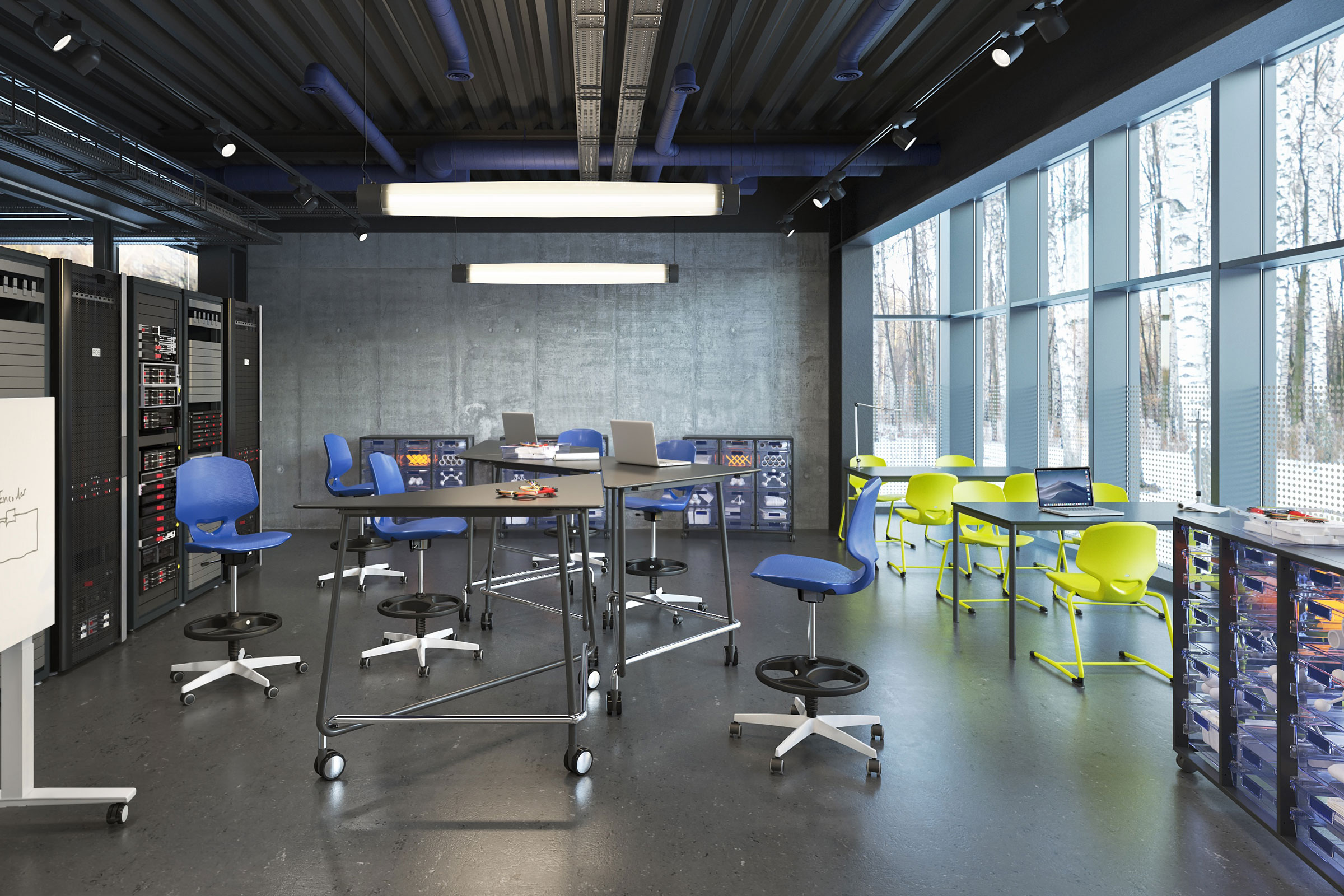Story at a glance:
- The role of furniture in CTE programs offers a peek into how agile, adjustable furniture can help all students learn better.
- CTE relies on hands-on, project-based learning to prepare students for the real world.
- Project-based learning includes a need for furniture that is adjustable, movable, and lightweight but also durable enough to hold specialized tools.
When Jill Ackers served as a technology director and engineering teacher, she encountered a critical obstacle: the constraints of the physical classroom environment. Rather than enhancing her mission to immerse students in hands-on, project-based learning, the classroom furniture was often a barrier. “I experienced firsthand how the built environment can hinder the effective delivery of an engineering curriculum,” she says.
For example, her classroom storage was neither mobile nor designed to hold tools ubiquitous in engineering—such as drills, soldering irons, hacksaws, and alligator clips. Ackers frequently spent her own money to buy bins (which often broke) and her own time to construct makeshift solutions out of plywood. She spoke with one teacher who shared a specific challenge while building complex robots that needed real-world testing space; the teacher couldn’t move the tables to allow enough room for testing. The robots, some as large as a go-kart, needed open, adaptable space that simply wasn’t available. “The teacher’s struggle underscored the need for agile, flexible learning environments that could accommodate such large-scale, hands-on projects central to CTE,” Ackers says.
Career and Technical Education (CTE) programs like those Ackers supported are designed to bridge educational experiences with workforce preparation in fields like robotics, engineering, skilled trades, automotive service, medical assistance, and cybersecurity. Today CTE programs serve more than 12 million high school and college students nationwide, with participation rates growing steadily each year. Research shows that students who complete a CTE program have a graduation rate over 90%, compared to the national average of around 85%. Additionally, more than 80% of CTE students report that the skills they acquired directly apply to their future careers.
Given the distinct demands of CTE (which serves students at the elementary through the collegiate level), the flexibility and functionality of the physical space and furniture in the school are crucial to student success. “In CTE the furniture isn’t just a backdrop,” Ackers says. “The furniture is part of the curriculum.” When thoughtfully selected, agile, adjustable furniture enables more than project-based learning; it becomes a tool that enhances the learning process itself, allowing students to engage more fully and authentically with the real-world skills they are there to acquire.
Today Ackers is the director of education at VS America, a company that creates ergonomic, sustainably made furniture designed to meet the needs of students and educators. Ackers works with researchers, principals, superintendents, teachers, curriculum directors, and other school staff members to encourage spatial proficiency, ensuring everyone understands how to use the furniture. She helps schools select and use furniture to create learning environments that are neuro-inclusive and mirror how humans come together.
In addition to providing training, Ackers often goes into the field with teachers. “It’s not just picking out a yellow or green chair,” she says. “All of these solutions come together to promote movement but also teaching practices.”
Human-Centric Design
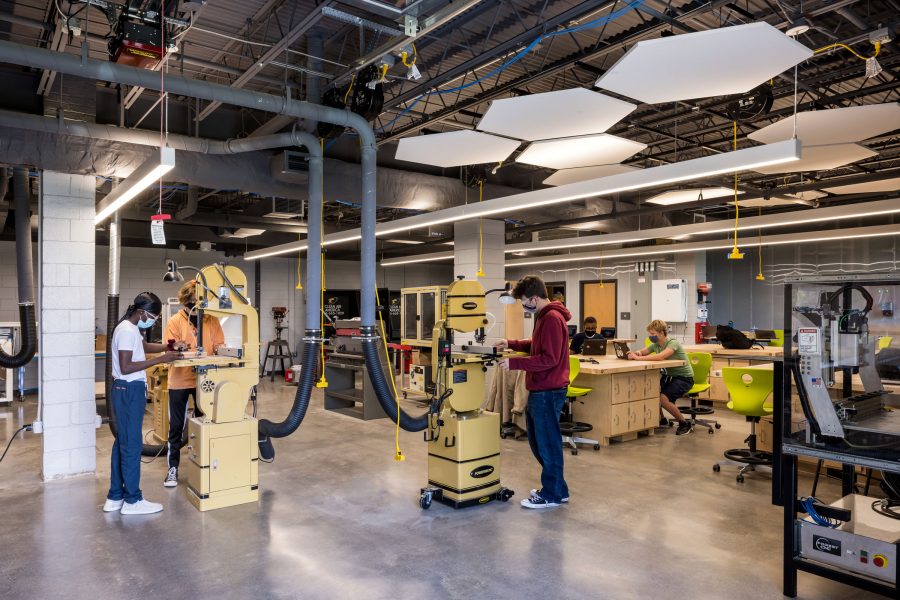
Students work on projects at the Emil + Grace Shihadeh Innovation Center. Photo by Lincoln Barbour
The US faces a shortage of skilled laborers like electricians and welders as well as workers in IT, tech, and health care. A report by organizational consulting firm Korn Ferry analyzes talent supply and demand in 20 economies around the world, including the US; it estimates that by 2030 more than 85 million jobs will go unfilled globally (including a deficit of 6 million-plus workers in the US specifically), due in large part to the dearth of training for skilled jobs.
Meanwhile the American Hospital Association expects a shortage of 100,000 critical health care workers by 2028. Plus, IT executives view talent shortages as the top barrier to adopting emerging technologies, according to a 2021 Gartner survey. CTE programs aim to help students gain the knowledge and practical experience needed to go out there and claim these jobs after graduation.
Winchester Public Schools in Winchester, Virginia, made it their mission to create a physical space suited for this purpose, where CTE teachers, academic teachers, and students could collaborate on real-world problems. VMDO Architects and Reader + Swartz Architects completed this project in 2021, resulting in the 54,000-square-foot Emil + Grace Shihadeh Innovation Center.
Kelly Callahan, licensed architect and K-12 studio principal for VMDO, says the design team engaged educators early on in the process. “The superintendent and his team of leaders for CTE programming had a really great vision for [the Innovation Center] in terms of making it a real transition from high school to college or from high school to independent, real-world living,” she says. “One of the things they imagined, which came to fruition, is that this place has no bells, so there’s no marking of time.”
School leadership wanted the Innovation Center to emphasize student autonomy, getting them ready for what work is like in real life, which includes managing your own time. Students get a three-hour block to spend at the center—whether they choose morning or afternoon, where they study in the building, and how they integrate their core curriculum time into the workforce training time is all up to them. “All of that is very intentionally blended in this facility,” Callahan says.
The center houses John Handley High School’s CTE classes and is organized into three academies: Professional Skills Academy, Health Sciences Academy, and Advanced Technologies Academy. Each has its own branding—including color, icon, photography, and encouraging words that frame their area of the building.
The color of each academy carries through to the furniture palette, from materials and upholstery to plastics and metals. This attention to wayfinding in the center’s design facilitates students’ independent movement throughout the building. For example, students can easily identify where to find and return tools and supplies from storage areas. “The color of the furnishings absolutely contributes to the students’ ability to navigate the facility, supporting their autonomy,” Callahan says.
Tables & Chairs
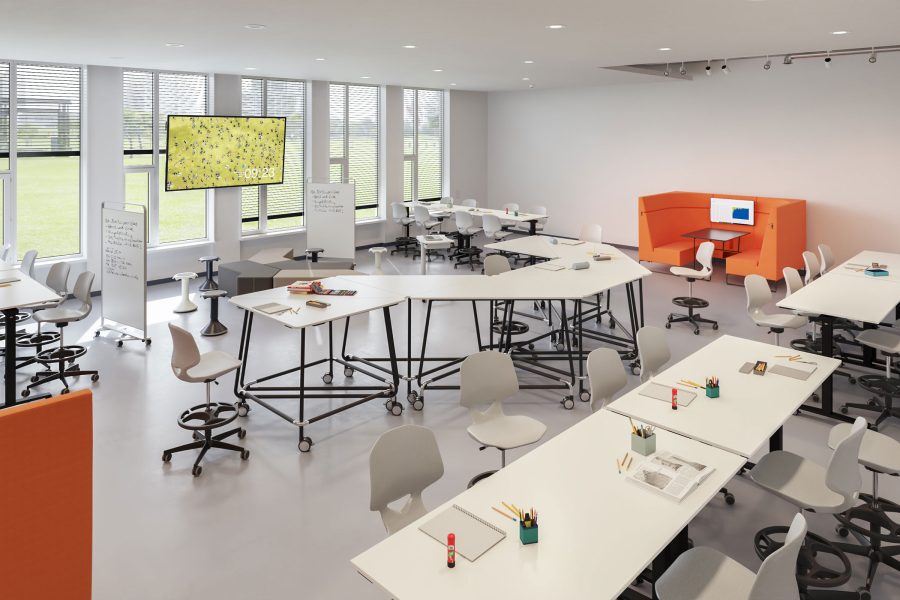
Photo courtesy of VS America
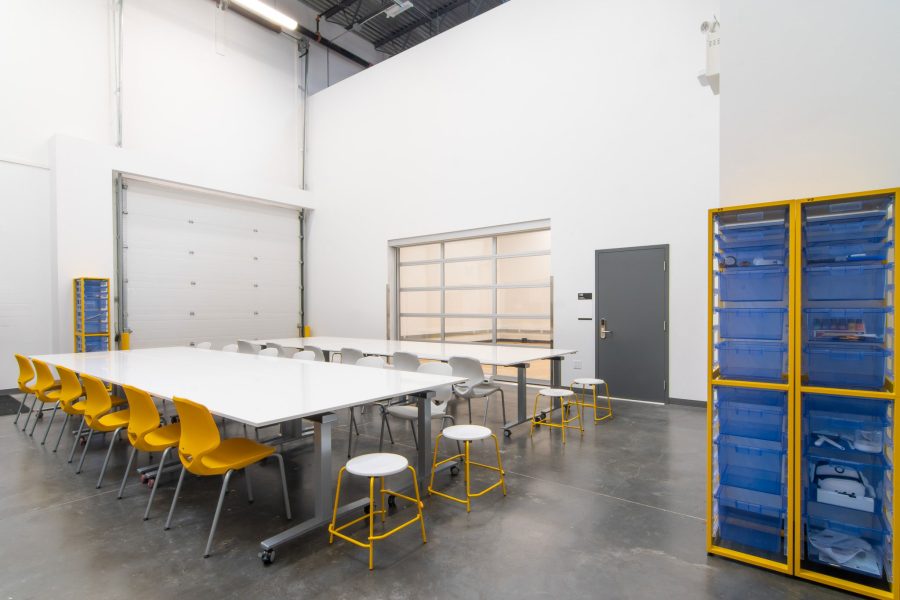
Furniture from VS America is seen here at the University of British Columbia. Photo by Andrew Lowes
In any classroom it’s vital to accommodate a variety of group sizes. Students constantly transition between independent work, collaboration in pairs and small groups, and larger group instruction. The teacher also has to be able to move between observing students, pulling up a chair to individual students, and speaking to the class as a whole.
The CTE environment heightens this need. On a practical level this means tables, chairs, and storage items need to be adjustable, movable, and lightweight but also durable enough to serve different-sized bodies and supplies. “You have to create the physical toolkit to go with all of the experiences we use to prepare students for their careers,” Ackers says.
The Innovation Center includes furniture from VS America like wheeled tables and chairs as well as stackable stools, flip tables, and efficient storage. One of the chair types is height adjustable with a patented 3D rocking mechanism that encourages natural movement and dynamic sitting. The seat area reacts to every change of weight and leans gently forward, backward, or sideways, continuously supporting changes between different sitting positions to ensure optimal ergonomic support.
A wide range of furniture, including writable and magnetic surfaces, is embedded into the center’s design. Callahan says this variety allows students and instructors to move furniture out of the way, meet in any size group, and collaborate on hands-on projects on surfaces that facilitate their progress rather than get in the way.
Ergonomics
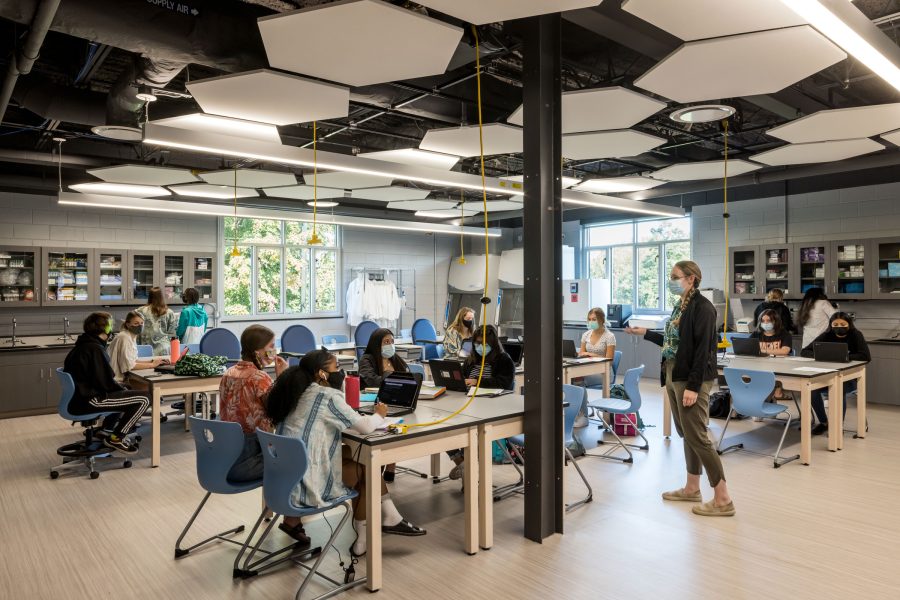
Class is in session at the Emil + Grace Shihadeh Innovation Center. Photo by Lincoln Barbour
Of course, if you’re physically uncomfortable, it’s hard to focus on working. That’s why Ackers says students need to have access to furniture options that work for—not against—their bodies. “How can we expect kids to focus on problem-solving and critical thinking when they’re uncomfortable?”
Ackers spoke with one teacher whose very tall student had to sit at a small table attached to a chair, squeezing his body in while trying to focus on group work. This is just one of many examples, she says, of what it feels like to be in a classroom where the furniture is not sized in an inclusive way.
“As a small stature person, I never really fit in my environment very well. And I’m a wiggler. I’m a doodler,” Callahan says of her childhood experiences as a student. “It doesn’t mean I’m not focused. It just means we all need the freedom to be able to move and choose an environment we’re comfortable in to best learn.”

